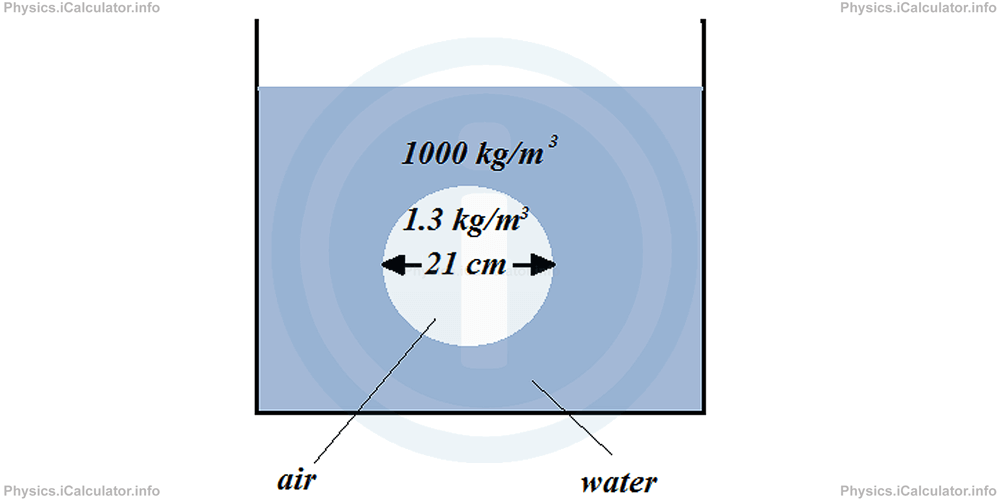Menu
Buoyancy. Archimedes' Principle
Please provide a rating, it takes seconds and helps us to keep this resource free for all to use
The following physics revision questions are provided in support of the physics tutorial on Buoyancy. Archimedes' Principle. In addition to this tutorial, we also provide revision notes, a video tutorial, revision questions on this page (which allow you to check your understanding of the topic) and calculators which provide full, step by step calculations for each of the formula in the Buoyancy. Archimedes' Principle tutorials. The Buoyancy. Archimedes' Principle calculators are particularly useful for ensuring your step-by-step calculations are correct as well as ensuring your final result is accurate.
Not sure on some or part of the Buoyancy. Archimedes' Principle questions? Review the tutorials and learning material for Buoyancy. Archimedes' Principle
| Tutorial ID | Title | Tutorial | Video Tutorial | Revision Notes | Revision Questions | |
|---|---|---|---|---|---|---|
| 9.5 | Buoyancy. Archimedes' Principle |
Buoyancy. Archimedes' Principle Revision Questions
1. What force is needed to keep a ball immersed in water if the ball's diameter is 21 cm? Take g = 10 m/s2, π = 22 / 7, ρwater = 1000 kg/m3 and the air density inside the ball as ρair = 1.3 kg/m3. Do not consider the material the ball is made (it is already included in the value of air density).

- 48.45 N
- 48.51 N
- 0.63 N
- 0.81 N
Correct Answer: A
2. An object weight 17 N on the ground and 12 N when immersed in water. What is the volume of this object in cm3? Take ρwater = 1000 kg/m3 and g = 10 m/s2.
- 0.0005 cm3
- 0.5 cm3
- 500 cm3
- 1200 cm3
Correct Answer: C
3. A balloon weighs 10000 N when empty. Its volume when flying is 2000 m3. The balloon works with hot air (ρhot air = 0.8 kg/m3). What additional weight can it carry to stay stationary in air? Take ρcold air = 1.3 kg/m3 and g = 10 m/s2. Take the figure in the last solved example as a reference.
- 26 000 N
- 16 000 N
- 10 000 N
- 0 N
Correct Answer: D
(the balloon is already stationary in air)
Whats next?
Enjoy the "Buoyancy. Archimedes' Principle" practice questions? People who liked the "Buoyancy. Archimedes' Principle" practice questions found the following resources useful:
- Practice Questions Feedback. Helps other - Leave a rating for this practice questions (see below)
- Density and Pressure Physics tutorial: Buoyancy. Archimedes' Principle. Read the Buoyancy. Archimedes' Principle physics tutorial and build your physics knowledge of Density and Pressure
- Density and Pressure Revision Notes: Buoyancy. Archimedes' Principle. Print the notes so you can revise the key points covered in the physics tutorial for Buoyancy. Archimedes' Principle
- Check your calculations for Density and Pressure questions with our excellent Density and Pressure calculators which contain full equations and calculations clearly displayed line by line. See the Density and Pressure Calculators by iCalculator™ below.
- Continuing learning density and pressure - read our next physics tutorial: Bernoulli Equation
Help others Learning Physics just like you
Please provide a rating, it takes seconds and helps us to keep this resource free for all to use
We hope you found this Physics tutorial "Buoyancy. Archimedes' Principle" useful. If you did it would be great if you could spare the time to rate this physics tutorial (simply click on the number of stars that match your assessment of this physics learning aide) and/or share on social media, this helps us identify popular tutorials and calculators and expand our free learning resources to support our users around the world have free access to expand their knowledge of physics and other disciplines.